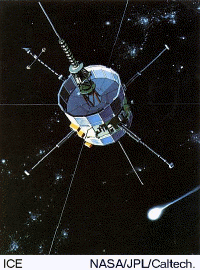ICE (International Cometary Explorer)

ICE (International Cometary Explorer) was a probe that was originally known as ISEE-3 (International Sun-Earth Explorer 3) but was renamed ICE when it was reactivated and diverted, after four years service, in order to pass through the tail of Comet Giacobini-Zinner and to observe Halley's Comet from a distance of 28 million kilometers.
ICE became the first spacecraft to be steered by chaotic control – a technique that allowed the probe to be directed to its cometary encounters despite having very little remaining fuel. With major rocket maneuvers out of the question, mission controllers decided to see if they could exploit the gravitational instability in the region of two Lagrangian points, the Sun-Earth and Earth-Moon L1 points, to coax ISEE-3 onto its new deep-space trajectory. On 10 June 1982, they began a series of 15 small burns to gradually nudge the satellite onto a path toward the Earth-Moon L1 point. Once they had the satellite in the Earth-Moon system, they flew it past the Earth-Moon L1 point five times, giving it a tiny boost on each lunar flyby, until they had it on a path that would eventually lead to a rendezvous with Giacobini-Zinner. The fifth and final lunar flyby took place on 22 December 1983, when the satellite passed just 119 kilometers above the Apollo 11 landing site. It was at this point that the spacecraft was renamed the ICE.
On 5 June 1985, ICE passed through Giacobini-Zinner's plasma tail, 26,550 kilometers behind the comet's nucleus, making measurements of particles, fields, and waves. In March 1986, it passed between the Sun and Halley's Comet, adding to the data collected by other spacecraft – Giotto, Planet-A, MS-T5, and Vega – which were in the vicinity of Halley on their rendezvous missions. Thus ICE became the first spacecraft to directly investigate two comets. Its mission was further extended by NASA in 1991 to include studies of coronal mass ejections in coordination with ground-based observations, continued cosmic ray studies, and special periods of observation such as when ICE and Ulysses were on the same solar radial line. Finally, ICE was shutdown on May 1997. The spacecraft will return to the vicinity of the Earth in 2014, when it may be possible to capture it and bring it home. NASA has already donated it to the Smithsonian Institute in the event of a successful recovery.


